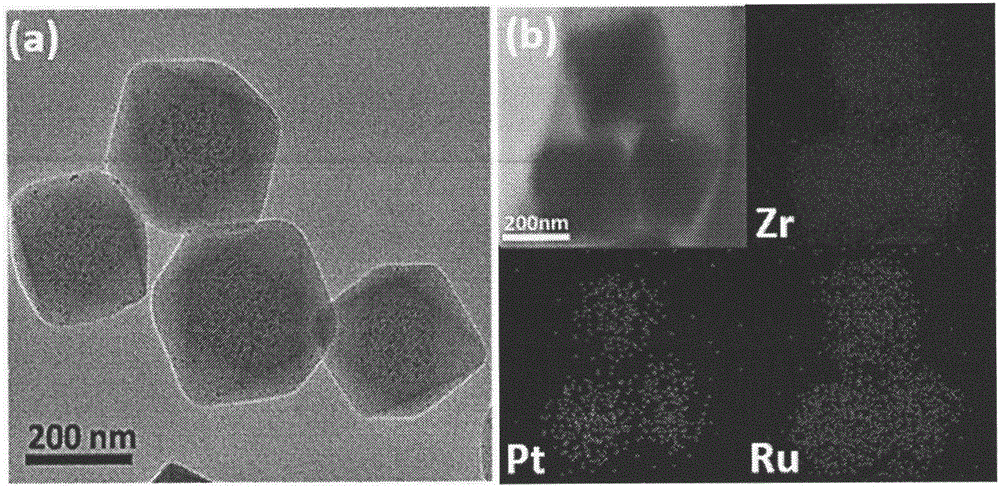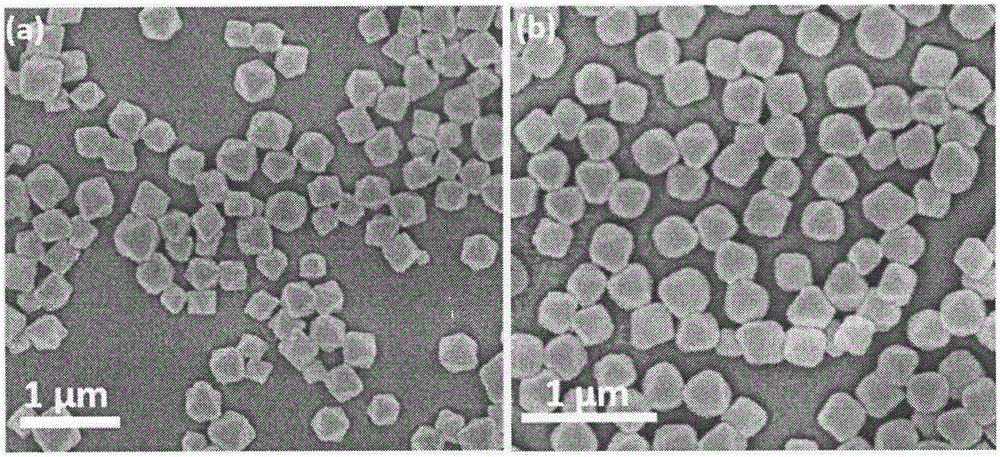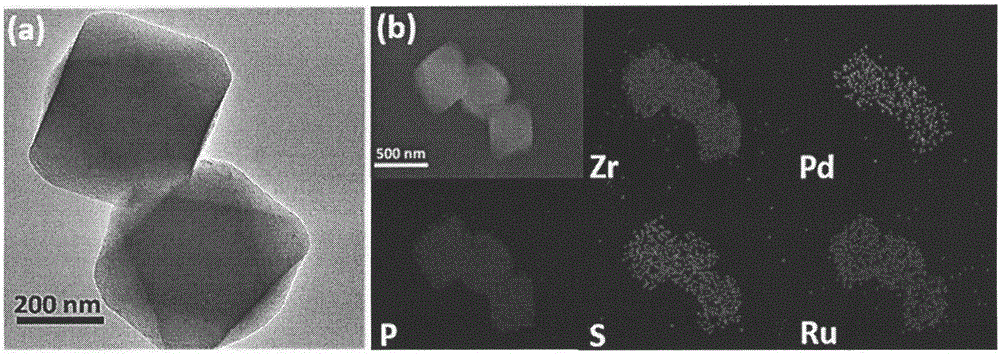Preparation method of nanometer particle-photosensitive porous coordination polymer composition material photocatalyst
A nanoparticle, porous coordination technology, applied in organic compound/hydride/coordination complex catalysts, physical/chemical process catalysts, chemical instruments and methods, etc., can solve the problem of size and shape of nanoparticles and composite materials Controllability, fewer types of visible light hydrogen production systems, etc., to achieve the effect of uniform size, regular shape, and maintain catalytic activity
- Summary
- Abstract
- Description
- Claims
- Application Information
AI Technical Summary
Problems solved by technology
Method used
Image
Examples
example 1
[0024] Zirconium tetrachloride (20mg), biphenyl dicarboxylic acid (16.1mg), containing [Ru(bpy) 3 ] 2+ Dicarboxylic acid (10mg) was dissolved in dimethylformamide solvent (3ml), then the dimethylformamide solution (120μl) of Pt nanoparticles modified by PVP and acetic acid regulator (165μl) were added, after mixing evenly, static Set, carry out hydrothermal reaction at 100°C, and the reaction time is 24 hours. After the reaction, the precipitate was collected by centrifugation, washed three times with dimethylformamide and methanol as solvents, and dried in vacuum to obtain the composite material Pt@RuUIO67-1. figure 1 , figure 2 a and Figure 5 The TEM, HAADF-STEM, EDX-mapping, SEM and XRD images show that the PVP-modified Pt nanoparticles can be successfully encapsulated in the photosensitized PCPs (RuUIO67) uniformly and without aggregation by in-situ encapsulation.
example 2
[0026] Zirconium tetrachloride (20mg), biphenyl dicarboxylic acid (14.6mg), containing [Ru(bpy) 3 ] 2+ Dicarboxylic acid (14mg) was dissolved in dimethylformamide solvent (3ml), then the dimethylformamide solution (120μl) and acetic acid regulator (165μl) of PVP modified Pt nanoparticles were added, after mixing evenly, let stand , The hydrothermal reaction was carried out at 100°C, and the reaction time was 24 hours. After the reaction, the precipitate was collected by centrifugation, washed three times with dimethylformamide and methanol as solvents, and dried in vacuum to obtain the composite material Pt@RuUIO67-2. figure 2 SEM and Figure 5 The XRD patterns of the obtained Pt@RuUIO67 composites with uniform structure can still be obtained by increasing the proportion of photosensitive metal-organic ligand units.
example 3
[0028] Zirconium tetrachloride (20mg), biphenyl dicarboxylic acid (16.1mg), containing [Ru (bpy) 3 ] 2+ Dicarboxylic acid (10 mg) was dissolved in dimethylformamide solvent (3 ml), followed by the addition of PVP-modified Pd 3 P 2 S 8 Dimethylformamide solution of nanoparticles (300 μl) and acetic acid regulator (165 μl) were mixed evenly, left to stand, and hydrothermal reaction was carried out at 100° C., and the reaction time was 24 hours. After the reaction, the precipitate was collected by centrifugation, washed three times with dimethylformamide and methanol as solvents, and dried in vacuum to obtain the composite material Pd 3 P 2 S 8 @RuUIO67-1. image 3 , Figure 4a and Figure 5 TEM, HAADF-STEM, EDX-mapping, SEM and XRD of the XRD patterns of PVP-modified Pd in addition to Pt nanoparticles 3 P 2 S 8 Nanoparticles can also be used as co-catalysts to be successfully encapsulated in RuUIO67 uniformly and without aggregation through the method proposed by th...
PUM
 Login to View More
Login to View More Abstract
Description
Claims
Application Information
 Login to View More
Login to View More - R&D
- Intellectual Property
- Life Sciences
- Materials
- Tech Scout
- Unparalleled Data Quality
- Higher Quality Content
- 60% Fewer Hallucinations
Browse by: Latest US Patents, China's latest patents, Technical Efficacy Thesaurus, Application Domain, Technology Topic, Popular Technical Reports.
© 2025 PatSnap. All rights reserved.Legal|Privacy policy|Modern Slavery Act Transparency Statement|Sitemap|About US| Contact US: help@patsnap.com



